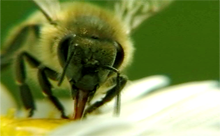Honeybee neurobiology and behavior – a tribute to Randolf Menzel

Table of Contents:
For a free previes of the book please click here
1. Mechanisms of social organization
1.1. The spirit of the hive and how a superorganism evolves
Rob Page (Tempe, USA)
1.2. Vitellogenin in honey bee behavior and lifespan
Gro Amdam et al. (Tempe, USA)
1.3. Circadian rhythms and sleep in honey bees
Guy Bloch et al. (Jerusalem, Israel)
1.4. Mechanisms of social organization: commentary
Randolf Menzel
2. Communication and navigation
2.1. Foraging honey bees: how foragers determine and transmit information about feeding site locations
Harald Esch (Notre Dame, USA)
2.2. How do honey bees obtain information about direction by following dances?
Axel Michelsen (Odense, Denmark)
2.3. Progress in understanding how the waggle dance improves the foraging efficiency of honey bee colonies
Tom Seeley (Cornell, USA)
2.4. Olfactory information transfer during recruitment in honey bees
Walter Farina et al. (Buenos Aires, Argentina)
2.5. Navigation and communication in honey bees
Uwe Greggers, Randolf Menzel et al. (Berlin, Germany)
2.6. Communication and navigation: commentary
Randolf Menzel
3. Brain anatomy and physiology
3.1. The digital honey bee brain atlas
Jürgen Rybak (Berlin, Germany)
3.2. Plasticity of synaptic microcircuits in the mushroom-body calyx of the
honey bee
Wolfgang Rössler and Claudia Groh (Würzburg, Germany)
3.3. Neurotransmitter systems in the honey bee brain: functions in learning and memory
Monique Gauthier (Toulouse, France) and Bernd Grünewald (Frankfurt, Germany)
3.4. Glutamate neurotransmission in the honey bee central nervous system
Gerard Leboulle (Berlin, Germany)
3.5. Cellular physiology of the honey bee brain
Bernd Grünewald (Frankfurt, Germany)
3.6. Dopamine signalling in the bee
Alison Mercer et al. (Otago, New Zealand)
3.7. Neuropeptides in honey bees
Giovanni Galizia and Sabine Kreissl (Konstanz, Germany)
3.8. Brain anatomy and physiology: commentary
Randolf Menzel
4. Sensory systems
4.1. Olfaction in honey bees: from molecules to behaviour
Jean-Christophe Sandoz (Toulouse, France)
4.2. Taste perception in honey bees
Gabriela de Brito Sanchez (Toulouse, France)
4.3. The auditory system of the honey bee
Hiro Ai and Tsunao Itoh (Fukuoka, Japan)
4.4. Vision of the honey bee in relation to flower patterns
Misha Vorobyev et al. (Auckland, New Zealand)
4.5. Psychophysics of honey bee color processing in complex environments
Adrian Dyer (Monash, Australia)
4.6. Sensory systems: commentary
Randolf Menzel
5. Genetics and molecular biology
5.1. Neurogenomic and neurochemical dissection of honey bee dance communication
Gene Robinson et al. (Urbana-Champaign, USA)
5.2. Molecular dissection of the honeybee brain: an approach to solving the mystery of dance communication and the sociality of the honey bee
Takeo Kubo (Tokyo, Japan)
5.3. Molecular insights into honey bee brain plasticity
Judith Reinhard and Charles Claudianos (Queensland, Australia)
5.4. Elucidating the path from genotype to behaviour in honey bees: insights from epigenomics?
Ryszard Maleszka (Canberra, Australia)
5.5. Genetics and molecular biology: commentary
Randolf Menzel
6. Learning and memory
6.1. Distributed plasticity for olfactory learning and memory in the honey bee brain
Brian Smith et al. (Tempe, USA)
6.2. The molecular biology of learning and memory - memory phases and signaling cascades
Uli Müller (Saarbrücken, Germany)
6.3. Extinction learning in honey bees
Dorothea Eisenhardt (Berlin, Germany)
6.4. Tactile antennal learning in the honey bee
Joachim Erber (Berlin, Germany)
6.5. Testing mathematical laws of behavior in the honey bee
Ken Cheng (Sydney, Australia)
6.6. Visual cognition in honey bees: from elemental visual learning to non‐elemental problem solving
Martin Giurfa (Toulouse, France)
6.7. Learning and memory: commentary
Randolf Menzel
